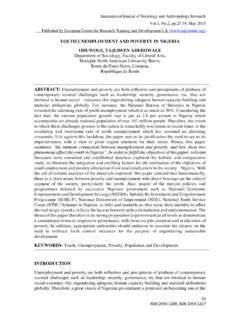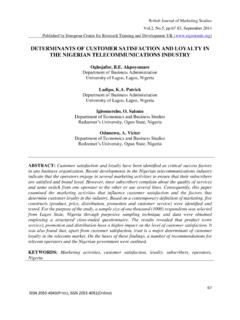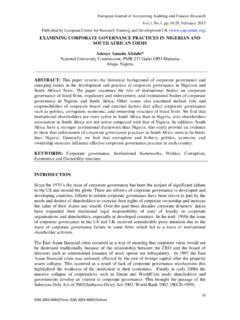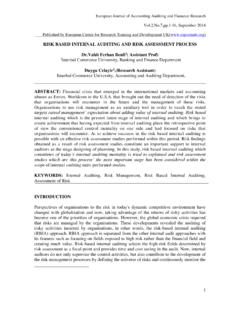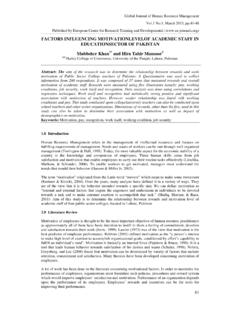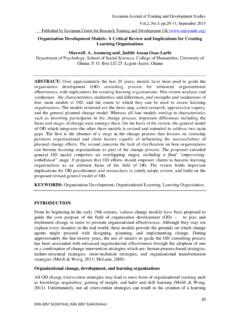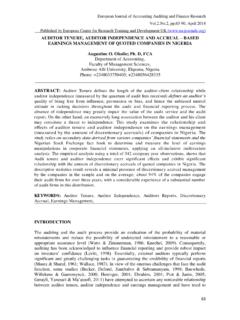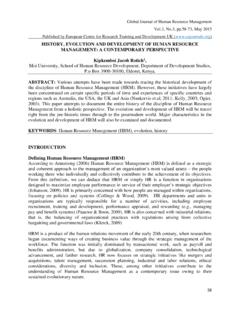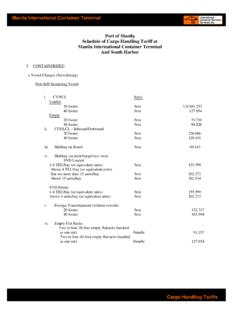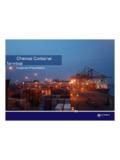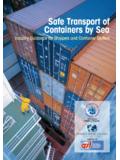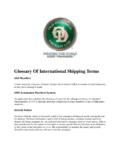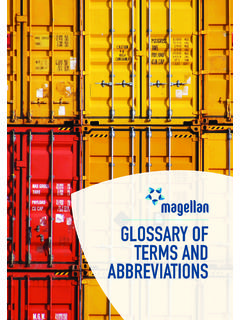Transcription of FACTORS INFLUENCING CONTAINER TERMINALS …
1 European Journal of Logistics Purchasing and Supply Chain Management , , pp. 39-78, December 2014 Published by European Centre for Research Training and Development UK ( ) 39 ISSN 2054-0930 (Print), ISSN 2054-0949 (Online) FACTORS INFLUENCING CONTAINER TERMINALS EFFICIENCY: A CASE STUDY OF MOMBASA ENTRY PORT Samuel Monday Nyema Department of Procurement in the School of Entrepreneurship, Procurement and Management Jomo Kenyatta University of Agriculture and Technology. ABSTRACT: Previous studies carryout revealed that many FACTORS influence CONTAINER terminal efficiency. This study revealed that FACTORS such as inadequate quay/gantry crane equipment, reducing berth times and delays of CONTAINER ships, dwell time, CONTAINER cargo and truck turnaround time, custom clearance, limited storage capacity, poor multi-modal connections to hinterland and infrastructure directly INFLUENCING CONTAINER terminal efficiency.
2 The research document thoroughly explored these FACTORS and discussed the extent to which they influence CONTAINER terminal efficiency within the port industry. The primary objective of this study was to assess FACTORS INFLUENCING CONTAINER TERMINALS Efficiency with a case study of the Mombasa Entry Port. The target population of the study was approximately 500 people which included Kenya Port Authority, Conventional Cargo Operations, and CONTAINER terminal Operations. Questionnaire was the major instrument used to obtain primary data from the respondents; while the secondary data were obtained from existing empirical literature relevant to the study. The study employed an exploratory approach using a descriptive survey design.
3 The questionnaire be designed using Likert scale type. A sample of 50 respondents was obtained through a stratified sampling technique of which 30 of the respondents participated in the survey. Data were analyzed using the Statistical Package for Social Sciences (SPSS) and Microsoft Excel 2013. The findings revealed of the respondents believe that by improving the infrastructures at the port of Mombasa will minimize the congestion problems that sometime occur. Findings from the survey revealed that of the respondents agree that the lack of Integrated IT system poses substantial delays in custom clearance procedures. The study also recommended that Kenya Port Authority (KPA) continuously invest in modern quay and gantry cranes to supplement the current ones in order to continuously enhance productivity of port operations and that the Government of Kenya invest in expanding the physical infrastructure such as adequate berthing facilities, wharves, yard capacity, quayside, railway, as well as hinterland connections expansion.
4 KEYWORDS: CONTAINER TERMINALS , Efficiency, Mombasa Entry INTRODUCTION Background Containerization of ship cargo was first introduced in 1956 (Levinson, 2006), aiming to cut down the costs of maritime transport by reducing cargo handling costs. Instead of loading/unloading each piece of transport item to or from a ship in a labor-intensive manner, containerization increases the efficiency and speed of transport by reducing the packing requirements and handling processes at all transfer points. That is between port, rail and road. At the end of 2005, the world CONTAINER fleet was expected to have increased to million TEUs (Twenty-foot equivalent units) (UNCTAD, 2006). Thus, countries without adequate unitized transport facilities will be disadvantage in their international trade (Castro, 1999).
5 European Journal of Logistics Purchasing and Supply Chain Management , , pp. 39-78, December 2014 Published by European Centre for Research Training and Development UK ( ) 40 ISSN 2054-0930 (Print), ISSN 2054-0949 (Online) In order to achieve economies of scales, new ships are built with much greater capacity. To date, the largest CONTAINER vessel can carry 11,000 TEUs. However, the deployment of larger ships demands huge investment in providing greater depth alongside the berth of the calling ports as well as more powerful quay cranes with long outreach and lift height. For efficient operation, ports also require a large storage yard and a better road and rail infrastructure. To satisfy the growing demand of CONTAINER berths, ESCAP (2005) estimates that US27 billion is needed from 2002 to 2015 for 569 new CONTAINER berth in the Asia and pacific region (ESCAP, 2005).
6 With regards to the growing international sea traffic and changing technology in the maritime transport industry, seaports are coping with mounting pressures to upgrade and provide cutting-edge technology. They are also being forced to improved CONTAINER TERMINALS efficiency to provide comparative advantages that will attract more traffic. Some of the key challenging FACTORS terminal operators are surmounting to is to secure traffic flows and prevent diversion to nearby ports including handling containers and cargos more rapidly, providing more adequate and performing equipment, reducing berth times and delays, enabling large storage capacity and ensuring multi-model connections to hinterland (Castro, 1999). However, CONTAINER TERMINALS efficiency is often associated with productivity and performance; also additional FACTORS that are associated with the more organizational side of production such as how efficiently ports use inputs to produce current output levels and whether the technologies adopted by CONTAINER terminal operators are most efficient, that are critical to determining CONTAINER TERMINALS efficiency(Chin and Tongzon, 1998).
7 Efficiency often means speed and reliability of CONTAINER terminal services. In a survey conducted by UNCTAD (2011), on-time delivery was cited to be a major concern by most shippers (UNCTAD, 2006). In fast-paced industries where products must be moved to the markets on time, terminal operators are vital nodes in logistics chain and as such must be in a position to guarantee shipping lines very reliable service levels. These include on-time berthing of vessels, guarantee turnaround time for vessels and guaranteed connection of containers. That is the total turnaround time it takes to wait for pilot to berth, terminal time, un-berthing and final departure from port area (Tongzon and Ganesalingam, 2009). terminal efficiency can be reflected in the freight rates charged by shipping companies, turnaround time of ships and cargo dwelling time.
8 The larger a ship stays at berth, the higher is the cost that a ship will have to pay. This can be passed on to shippers in terms of higher freight charges and longer cargo dwelling time, thus reducing the attractiveness for them to hub at a port. Tongeon and Ganesalingam (2009) identified several indicators of terminal efficiency and categorized them into two broad groups, namely: operational efficiency measures and customer-oriented measures. The first set of measure deals with capital and labor productivity as well as asset utilization rates. The second set includes direct charges, ship s waiting time, minimization of delays in inland transport and reliability (Tongzon and Ganesalingam, 2009). A Survey conducted by the East African Logistics Performance reveals significant improvement in port and corridor efficiency.
9 Ongoing reforms and infrastructure improvements at the port of Mombasa have yielded significant results as cargo dwell time has dropped from an average days in 2011 to 5 days in 2012. Despite these improvements, the efficiency at the port of Mombasa is still below the internationally acceptable standards of a maximum 3 days dwell time (East African Logistics Performance Survey, 2012). Compare to 2011, corridor efficiency has slightly improved resulting from concerted efforts by EAC governments to upgrade regional road infrastructure and eliminate non-tariff barriers. Despite European Journal of Logistics Purchasing and Supply Chain Management , , pp. 39-78, December 2014 Published by European Centre for Research Training and Development UK ( ) 41 ISSN 2054-0930 (Print), ISSN 2054-0949 (Online) these initiatives, truck turnaround times remain low as an average truck records less the 5,000 KMs per month against an industry practice of 9,000 to 12,000 KMs per months (East African Logistics Performance Survey, 2012).
10 The efficiency of CONTAINER terminal is still affected by the high regulatory burden of the road transport sector with numerous checkpoints (weight bridges, customs and police checks) along the transport corridor. This situation is compounded by congestion in urban areas along the transport corridor and less than adequate investment in the rail network to effectively complement the road transport system (East African Logistics Performance Survey, 2012). The Port of Mombasa is the largest in East Africa and a vital gateway for imports and exports to Kenya and its neighboring countries. The imports and exports that pass through the Port of Mombasa are critical to Kenya s economic growth, and to the economic well-being of its neighbors as well.


